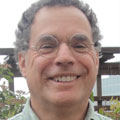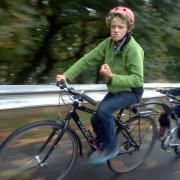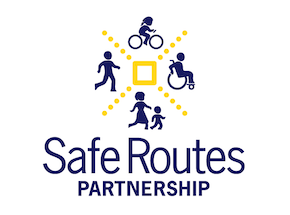 I have written before about how well the state network project is doing. Looking at the first seven months, I am happy to report there has been a real growth spurt as the number of participants increases, as do the contact lists. And the organizers’ skills are getting noticed as are the networks activities. Here are some snapshots:
I have written before about how well the state network project is doing. Looking at the first seven months, I am happy to report there has been a real growth spurt as the number of participants increases, as do the contact lists. And the organizers’ skills are getting noticed as are the networks activities. Here are some snapshots:
Resource Library
Montana Safe Routes to School continues to improve safety and healthy options for children across Montana. In March of 2012, Montana Safe Routes to School announced $928,406 in Safe Routes to School awards for state fiscal year 2013, which began July 1, 2012. Six communities were awarded infrastructure funding for projects ranging from $14,000 for signing and crossing improvements to $114,386 for a pathway in eastern Montana.
 The Safe Routes Partnership's state network project is working to get more Complete Streets policies and improve current ones. As we do this, we learned about several jurisdictions in Florida that have taken their own initiative and are doing just that. We will continue to work hard to make sure this trend continues in our network states!
The Safe Routes Partnership's state network project is working to get more Complete Streets policies and improve current ones. As we do this, we learned about several jurisdictions in Florida that have taken their own initiative and are doing just that. We will continue to work hard to make sure this trend continues in our network states!
In 2012, the MAP-21 transportation legislation made changes to the Federal Safe Routes to School program that added a required state or local match of up to 20 percent of project costs.
 New Jersey’s Zealous Nuts: The 2012 ProWalkProBike: Pro Place conference brought together hundreds of “zealous nuts” who are dedicated to people walking and bicycling more often. Fred Kent, founder of Project for Public Spaces, opened the c
New Jersey’s Zealous Nuts: The 2012 ProWalkProBike: Pro Place conference brought together hundreds of “zealous nuts” who are dedicated to people walking and bicycling more often. Fred Kent, founder of Project for Public Spaces, opened the c
This webinar from December 9, 2014 explores the process used to create Complete Streets in a variety of southern settings.
 There is a scene, from a once famous movie where this guy busts through the door to expel his undying affection for a woman. She completes him, and he wants to make sure she knows it.
There is a scene, from a once famous movie where this guy busts through the door to expel his undying affection for a woman. She completes him, and he wants to make sure she knows it.
I’m no Tom Cruise, but I want you to know: You complete me.
 The Safe Routes to School Mississippi network prides itself on the ability to connect with those organizations within the state that are passionate about ridding the state of the childhood obesity epidemic. We continue our efforts in expanding our parameters to partners that are champions for the cause. While attending a meeting with the Obesity Coalition (formulated by The Partn
The Safe Routes to School Mississippi network prides itself on the ability to connect with those organizations within the state that are passionate about ridding the state of the childhood obesity epidemic. We continue our efforts in expanding our parameters to partners that are champions for the cause. While attending a meeting with the Obesity Coalition (formulated by The Partn

 We travel just over two miles to school each day with our two boys - by bike, of course, most days. I am proud that my ten-year old son is now riding his six-year old brother to school on a tag-along! Both boys insist on it now. This picture shows the Big Guy showing off his tough guy face on a recent school trip.
We travel just over two miles to school each day with our two boys - by bike, of course, most days. I am proud that my ten-year old son is now riding his six-year old brother to school on a tag-along! Both boys insist on it now. This picture shows the Big Guy showing off his tough guy face on a recent school trip.
 The past several months have been rife with debates, campaign speeches and rallies supporting certain candidates, ideologies and policies. Over the past couple of weeks, many Americans have exercised their right to vote into office the state and local leaders of their choice as well as the President of the United States of America.
The past several months have been rife with debates, campaign speeches and rallies supporting certain candidates, ideologies and policies. Over the past couple of weeks, many Americans have exercised their right to vote into office the state and local leaders of their choice as well as the President of the United States of America.
To date, Georgia Safe Routes to School has awarded 48 projects (totaling approximately $18.5 million). Some examples of the various types of infrastructure projects are installation of sidewalks, multi-use paths, crosswalks, raised crosswalks, multi-use paths, LED crossing signs, ADA ramps, bike lanes and bike racks.
 Right now my work in the Bay Area region is at a very exciting phase. While earlier in the year our efforts were concentrated on our metropolitan planning organization (MPO)—the Metropolitan Transportation Commission (MTC)—our work now needs to focus on the nine counties of the San Francisco Bay Area.
Right now my work in the Bay Area region is at a very exciting phase. While earlier in the year our efforts were concentrated on our metropolitan planning organization (MPO)—the Metropolitan Transportation Commission (MTC)—our work now needs to focus on the nine counties of the San Francisco Bay Area.
The School Site Audit will help determine walking and bicycling conditions on or adjacent to school property. Similar to the School Site Audit, the Neighborhood Site Audit is designed to help you evaluate the walking and bicyclingconditions by inventorying neighborhood intersections, streets, and sidewalks used by the students.
 What better way to ring in the 2013 New Year than to reflect on what we are thankful for and resolve to improve.
What better way to ring in the 2013 New Year than to reflect on what we are thankful for and resolve to improve.
This report describes how student school travel in the U.S. changed from 1969through 2009 using information from the 2001 and 2009 National HouseholdTravel Survey (NHTS) and the 1969 and 1995 Nationwide Personal TransportationSurveys (NPTS).
 As we continue to hear more about the intersection of transportation and health issues nationally, Tennessee is making a concerted effort to cultivate this important partnership. Recently, I had the opportunity to witness and participate in this collaboration.
As we continue to hear more about the intersection of transportation and health issues nationally, Tennessee is making a concerted effort to cultivate this important partnership. Recently, I had the opportunity to witness and participate in this collaboration.
The Nevada statewide Safe Routes to School program is in its third round of national Safe Routes to School (SRTS) funding. Funding started in 2008 and the third round of SAFETEA-LU money is funded in 2012 and 2013. The state program covers the major urban areas in the state along with rural areas with a mixture of infrastructure and non-infrastructure projects. Approximately $10 million dollars has been spent or committed so far. There have been 25 projects with 12 partners in the state.
This fact sheet provides highlights from the 2009 National Household Travel Survey released in 2010.

